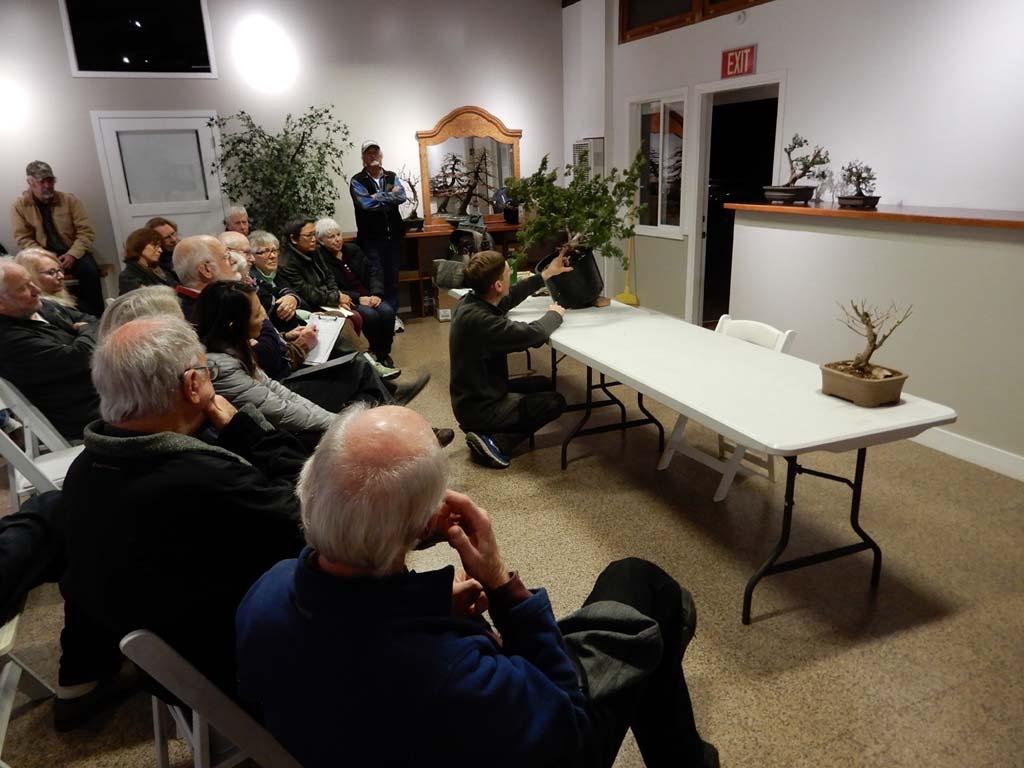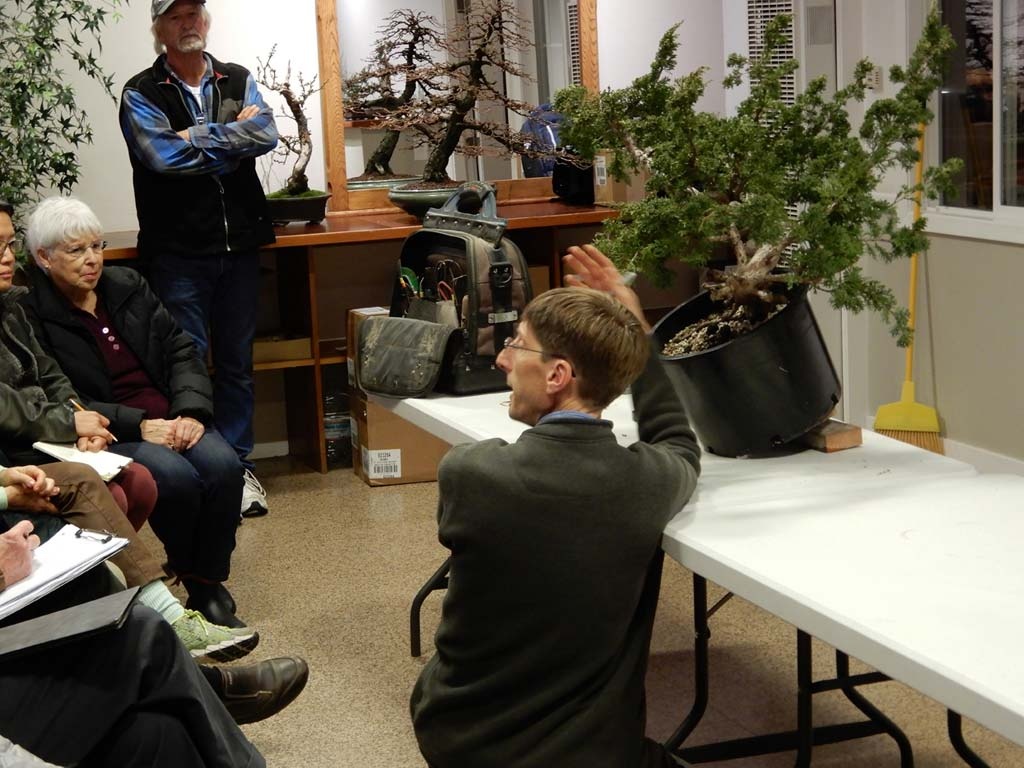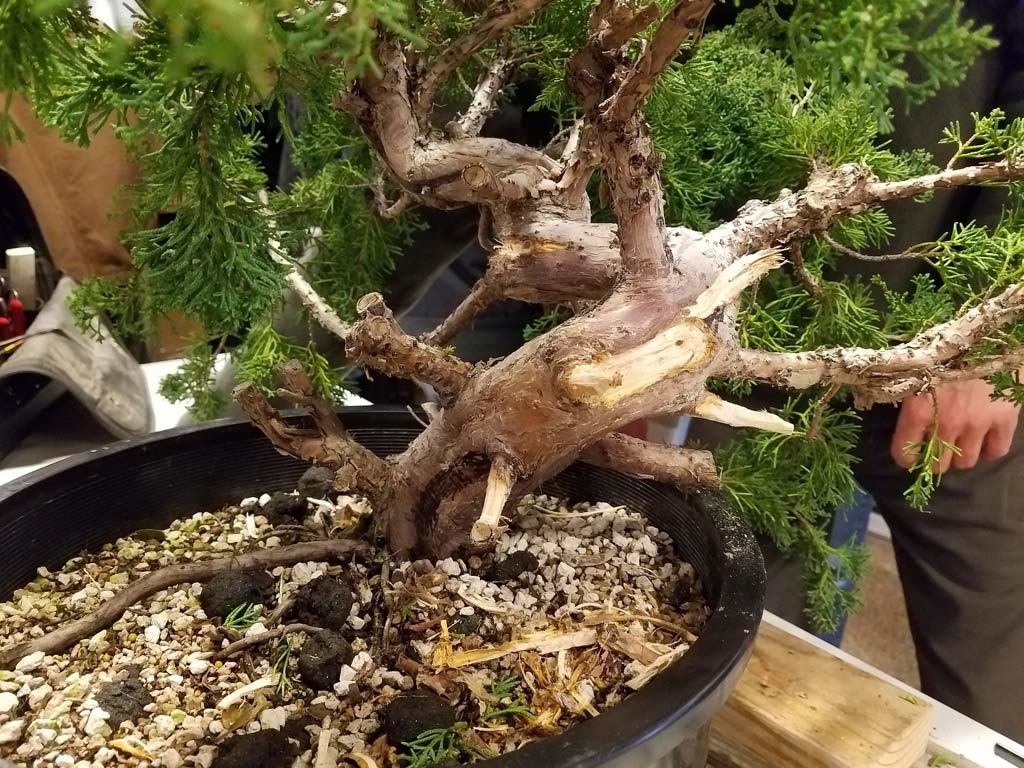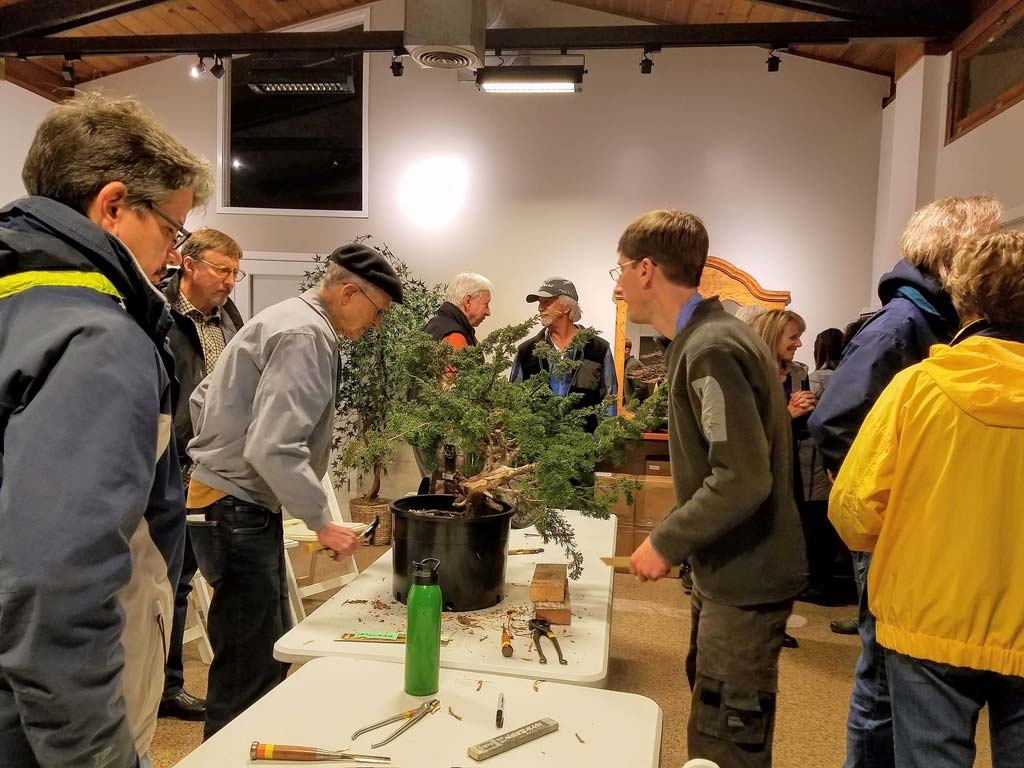This is the second of three Jonas Dupuich demo write-ups in this weekend’s triple play. – Ed. 5/18/19
Jonas Dupuich, local bonsai professional and the curator of bonsaitonight.com, joined us again at the beginning of 2019 to talk about carving deadwood. He brought a Shimpaku juniper with him to carve for demonstration purposes and a crape myrtle to raffle at the end of the night.
Jonas started by talking about the best trees for deadwood and when to create deadwood on a tree for the first time. He brought the juniper for demonstration and talked mostly about junipers because they are the trees most enhanced by deadwood. Most other trees can have deadwood, but it’s difficult to maintain on deciduous trees, which are more likely to rot away rather than dry out, and some varieties, like pine, are valued so much for their bark that stripping it off would be a bit crazy.

Junipers heal up so quickly, there’s no real point in carving a small one. It is common, however, to carve a collected or early-stage developing tree relatively early, because it’s easier to get to everything without fully developed branches getting in the way.
To round out his introduction, Jonas explained lifelines and the importance of not destroying too much of them. As has been seen on many a dramatic bonsai, a very high percentage of a juniper’s trunk can be dead, so long as there is a healthy lifeline running all the way from the roots to the foliage. Carefully tracing a lifeline, which can often perform many twists and turns, is challenging, but you also have to remember that it works both ways. It’s fairly intuitive that destroying a lifeline will kill the foliage above it, but you also have to remember that if you destroy too much of the apical foliage being fed by a lifeline, the tree may give up on that entire lifeline, killing not just the apex, but lesser branches along the way as well.

While on the topic of lifelines, Jonas added a side note, highly recommending twisting all branches when you wire them throughout the development of any bonsai. Twisting the branches not only adds more character, but it also adds more opportunities for intricate and fascinating deadwood should the desire to create some arise later on.
To segue into working on the Shimpaku juniper he brought with him, Jonas fielded suggestions as to where to start stripping bark to create a shari–an area of bark stripped along the trunk or a major branch. He talked a bit about where deadwood makes the most sense. For example, deadwood often occurs in association with dead branches, but it can also develop under live branches when some damage doesn’t heal properly because of the shade. Randomly placing deadwood where it doesn’t make sense will cause it to overpower the overall look, instead of blending in naturally and completing the tree’s overall “story.”

Once we had all agreed where it made the most sense to place a shari on the current tree, Jonas outlined the area with a black permanent ink pen. He highly recommends doing that so you don’t lose track of where you intended to cut, something that can easily happen once you get in close to make the cuts. To begin the cutting, Jonas likes to start with a very sharp (e.g., grafting) knife, cutting the lines he just drew to isolate the area of bark he will be stripping. That way he’s sure to avoid over-stripping into areas meant to be left alone, which can easily happen once the bark peeling begins, because it will often come right off in long . . . well, strips. Note that old, dead bark is considerably harder to strip than live bark. It’s often more of a chipping or chiseling activity than a stripping one, so if you know you’re going to strip a newly dead area eventually, it’s best to not let it sit for too long.
Because the selected area on Jonas’ tree contained a dead branch, he started with that first. There are advantages to starting with any dead branch stubs present in your intended deadwood area because, with the techniques Jonas was about to show us, you can greatly enhance the surrounding area by starting with the branch. But if you’re only stripping the branch to create what is called a jin, a completely bare deadwood branch, and don’t want to continue into the trunk, be sure to cut around the base of the branch first, just as Jonas demonstrated earlier with the edge of his entire shari area, so that you don’t go farther than you want to. The next step is to use pliers to squish and twist the bark off of the branch. If it doesn’t come off immediately, once the bark has separated from the interior of the branch (the cambium), simply grab the edge of some of the bark with pliers, preferably ones specifically made for jinning, and strip from the end of the branch to the line you cut around the base of the branch. If you’re having trouble getting a grip on the bark, Jonas recommends cross-cutting the end of the branch (to make a “+” if you look at it end-on) with a sharp knife to create something easier to grab with the pliers.

If you’re not turning the dead branch into a jin, but simply want to remove it, starting from a dead branch stump is a great way to begin a shari in the surrounding area of the trunk. The procedure is similar to that for creating a jin, described above, but you won’t want to cut a line at the base of the branch, and don’t bother peeling the bark off the branch. Simply crush the entire stump with pliers and peel entire lengthwise sections of the branch toward the trunk. When you get to the trunk, don’t hesitate, just keep tearing right into your desired shari area on the trunk. This allows you to peel deep, creating a hollow by the branch. After you strip enough pieces, you can usually pull the remaining stump of the branch right out, or leave a little nub if it’s particularly interesting. This technique provides a deeper, more natural, and often more dramatic, look to your deadwood.
Jonas gave us the following famous sensei quote: “Always make the first shari deep.” This is in reference to the new dimension a shari can add to a trunk or branch that would otherwise be too round and ordinary. Perhaps it also refers to the fact that you should jump right in and not hesitate to make a really good scar when you first commit to giving your bonsai some deadwood. Certainly if you don’t make enough of a scar, it will simply heal over because junipers heal that well. Also consider working on a shari over time, not necessarily to keep it from healing over, but because doing so adds multiple levels of healing and depth to the shari.
After carving away for awhile, getting help from an audience member at one point, and briefly showing a few specialized tools, Jonas covered two final topics: specialized techniques for a more natural look and deadwood preservation. To help get a more natural look, Jonas said to consider using wire brushes as an alternative to sandpaper for the final smoothing of your jins and sharis. Bear in mind that the steel bristles are stronger than brass. Another way to give your rough carving marks a more natural look is to wrap a wet towel around a jin for a few days, then take a wire brush to it.

The most popular way to keep your deadwood from rotting is to paint it with lime sulfur. Bear in mind, however, that lime sulfur doesn’t preserve the wood so much as it kills the algae that eats away at it. It is also more superficial than it seems. Often misperceived as a deep-seeping dye- or bleach-like substance, the bleached look actually comes right off, even with something as gentle as a toothbrush. So if you decide to use lime sulfur, be sure to re-treat your deadwood regularly. Likewise, if you try it and don’t like it, don’t panic, just scrub it off. The first time you plan to apply lime sulfur to new deadwood, let the wood dry for about four months before applying the lime sulfur. You can also color lime sulfur so it doesn’t leave quite such a ghost-white finish. India ink works best. A little bit goes a long way. You can also thin lime sulfur with water, with or without the coloring. Also consider other means of preventing your deadwood from rotting, like wood preservatives or careful maintenance and antifungal agents. Like most arts, bonsai is only limited by your imagination and ingenuity.

The crape myrtle raffle tree was won by Belinda Lee. Congratulations, Belinda!
– David Eichhorn
Photos by George Haas and Sharon Bone


